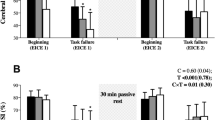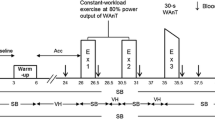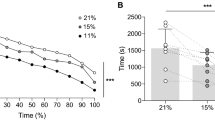Abstract
The purpose of this study was to investigate whether hypoxia can alter anaerobic energy release during supramaximal exercise. Seven male subjects performed 12 submaximal cycling tests to establish the relationship between workload and O2 demand. The subjects also performed 40 s Wingate tests (WT) under normoxia (room air), two levels of moderate hypoxia of 16.4% O2 and 12.7% O2. We measured the power output and oxygen uptake (VO2) during each test and estimated the O2 demand, O2 deficit and percentage of anaerobic energy release (%AnAER). These data were analyzed for each 20 s interval. At all intervals, there were no differences in Pmean·body mass (BM)−1, O2 demand·BM−1 or O2 deficit·BM−1 among the three O2 conditions. However, under hypoxia of 12.7%, VO2·BM−1 was significantly decreased and %AnAER was significantly increased in the late phase (20–40 s) of the WT, compared to normoxia (P<0.05). There were no such significant differences between normoxia and hypoxia of 16.4%. Thus, the present results show that the degree of hypoxia affects the magnitude of the hypoxia-induced increase in anaerobic energy release in the late phase of the WT and suggest that certain degrees of hypoxia induce significant increases in the amount of anaerobic energy released, compared to normoxia.

Similar content being viewed by others
References
Bangsbo J (1994) Energy demands in competitive soccer. J Sports Sci 12:S5–S12
Beneke R, Pollmann C, Bleif I, Leithauser RM, Hutler M (2002) How anaerobic is the Wingate Anaerobic Test for humans? Eur J Appl Physiol 87:388–392
Calbet JA, Chavarren J, Dorado C (1997) Fractional use of anaerobic capacity during a 30- and a 45-s Wingate test. Eur J Appl Physiol Occup Physiol 76:308–313
Calbet JA, Boushel R, Radegran G, Sondergaard H, Wagner PD, Saltin B (2003a) Determinants of maximal oxygen uptake in severe acute hypoxia. Am J Physiol Regul Integr Comp Physiol 284:R291–R303
Calbet JA, De Paz JA, Garatachea N, Cabeza De Vaca S, Chavarren J (2003b) Anaerobic energy provision does not limit Wingate exercise performance in endurance-trained cyclists. J Appl Physiol 94:668–676
Carter H, Jones AM, Barstow TJ, Burnley M, Williams CA, Doust JH (2000) Oxygen uptake kinetics in treadmill running and cycle ergometry: a comparison. J Appl Physiol 89:899–907
Dick FW (1992) Training at altitude in practice. Int J Sports Med 13:S203–S206
Fujimaki T, Asano K, Mizuno K, Okazaki K (1999) Effect of high-intensity intermittent training at simulated altitude on aerobic and anaerobic capacities and response to supramaximal exercise. Adv Exerc Sports Physiol 5:61–70
Fulco CS, Rock PB, Cymerman A (1998) Maximal and submaximal exercise performance at altitude. Aviat Space Environ Med 69:793–801
Hill DW, Halcomb JN, Stevens EC (2003) Oxygen uptake kinetics during severe intensity running and cycling. Eur J Appl Physiol 89:612–618
Jacobs I, Bar-Or O, Karlsson J, Dotan R, Tesch P, Kaiser P, Inbar O (1982) Changes in muscle metabolites in females with 30-s exhaustive exercise. Med Sci Sports Exerc 14:457–460
Lakomy HK (1986) Measurement of work and power output using friction-loaded cycle ergometers. Ergonomics 29:509–517
Linnarsson D, Karlsson J, Fagraeus L, Saltin B (1974) Muscle metabolites and oxygen deficit with exercise in hypoxia and hyperoxia. J Appl Physiol 36:399–402
McLellan TM, Kavanagh MF, Jacobs I (1990) The effect of hypoxia on performance during 30 s or 45 s of supramaximal exercise. Eur J Appl Physiol Occup Physiol 60:155–161
McLellan TM, Cheung SS, Meunier MR (1993) The effect of normocapnic hypoxia and the duration of exposure to hypoxia on supramaximal exercise performance. Eur J Appl Physiol Occup Physiol 66:409–414
Medbø JI, Tabata I (1989) Relative importance of aerobic and anaerobic energy release during short-lasting exhausting bicycle exercise. J Appl Physiol 67:1881–1886
Medbø JI, Mohn AC, Tabata I, Bahr R, Vaage O, Sejersted OM (1988) Anaerobic capacity determined by maximal accumulated O2 deficit. J Appl Physiol 64:50–60
Ogita F, Tabata I (1999) The effect of high intensity intermittent training under a hypobaric hypoxic condition on anaerobic capacity and maximal oxygen uptake. In: Keskinen KL, Komi PV, Hollander AP (eds) Biomechanics and medicine of swimming VIII. Gummerus Printing, Jyvaskyla, pp 423–428
Parolin ML, Chesley A, Matsos MP, Spriet LL, Jones NL, Heigenhauser GJ (1999) Regulation of skeletal muscle glycogen phosphorylase and PDH during maximal intermittent exercise. Am J Physiol 277:E890–E900
Pugh LG (1965) Altitude and athletic performance. Nature 207:1397–1398
Truijens MJ, Toussaint HM, Dow J, Levine BD (2003) Effect of high-intensity hypoxic training on sea-level swimming performances. J Appl Physiol 94:733–743
Tumilty D (1993) Physiological characteristics of elite soccer players. Sports Med 16:80–96
Weyand PG, Lee CS, Martinez-Ruiz R, Bundle MW, Bellizzi MJ, Wright S (1999) High-speed running performance is largely unaffected by hypoxic reductions in aerobic power. J Appl Physiol 86:2059–2064
Wilber RL (2004) Altitude training and athletic performance. Human Kinetics, Champaign
Withers RT, Sherman WM, Clark DG, Esselbach PC, Nolan SR, Mackay MH, Brinkman M (1991) Muscle metabolism during 30, 60 and 90 s of maximal cycling on an air-braked ergometer. Eur J Appl Physiol Occup Physiol 63:354–362
Yamamoto M, Kanehisa H (1995) Dynamics of anaerobic and aerobic energy supplies during sustained high intensity exercise on cycle ergometer. Eur J Appl Physiol Occup Physiol 71:320–325
Acknowledgements
The present work was partly supported by the Juntendo University Presidential Grant for Inter-Faculty Joint Research (K-435) and a grant (HRC-H17) from Juntendo University.
Author information
Authors and Affiliations
Corresponding author
Additional information
An erratum to this article is available at http://dx.doi.org/10.1007/s00421-006-0283-9.
Rights and permissions
About this article
Cite this article
Ogura, Y., Katamoto, S., Uchimaru, J. et al. Effects of low and high levels of moderate hypoxia on anaerobic energy release during supramaximal cycle exercise. Eur J Appl Physiol 98, 41–47 (2006). https://doi.org/10.1007/s00421-006-0214-9
Accepted:
Published:
Issue Date:
DOI: https://doi.org/10.1007/s00421-006-0214-9




